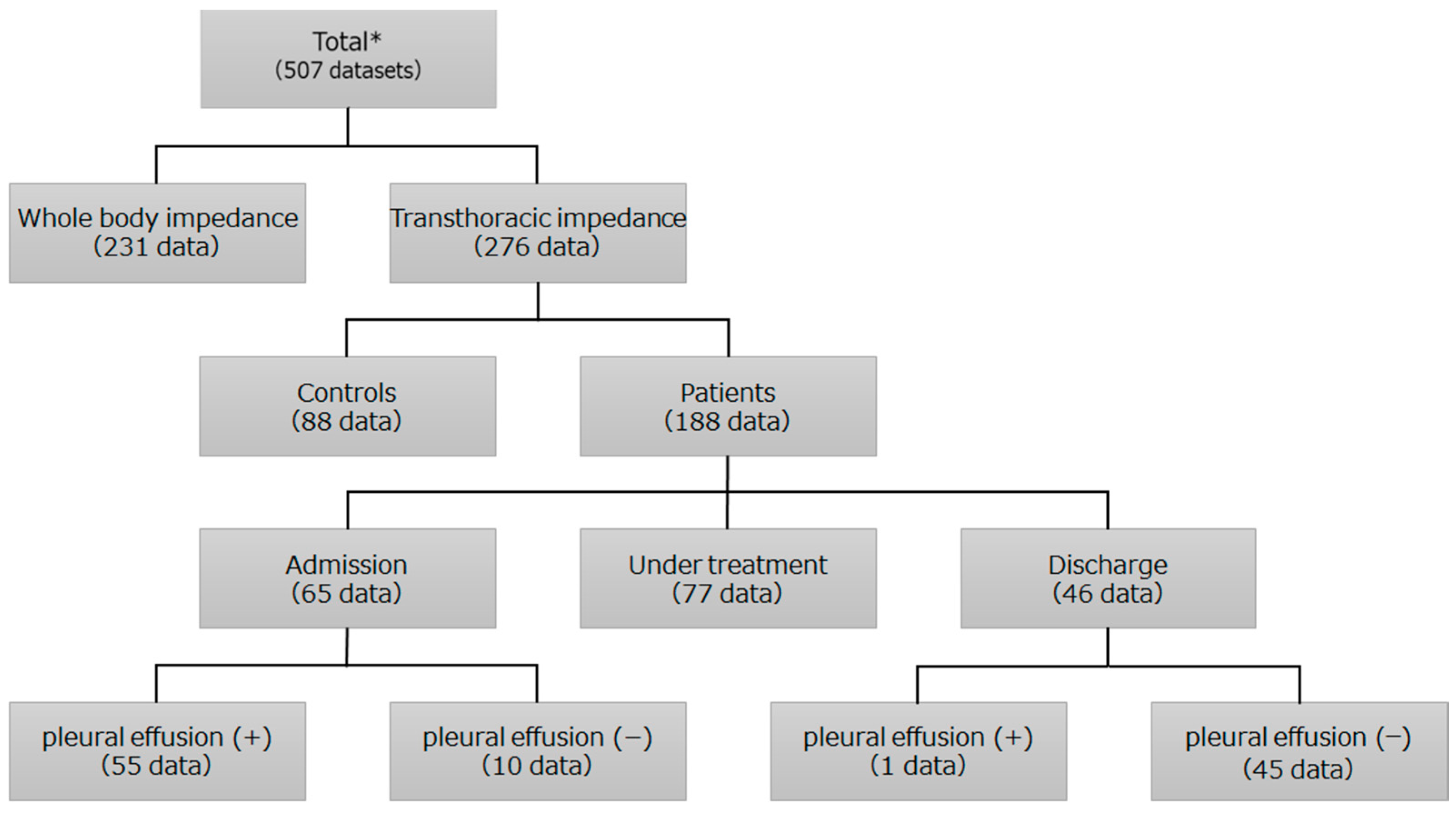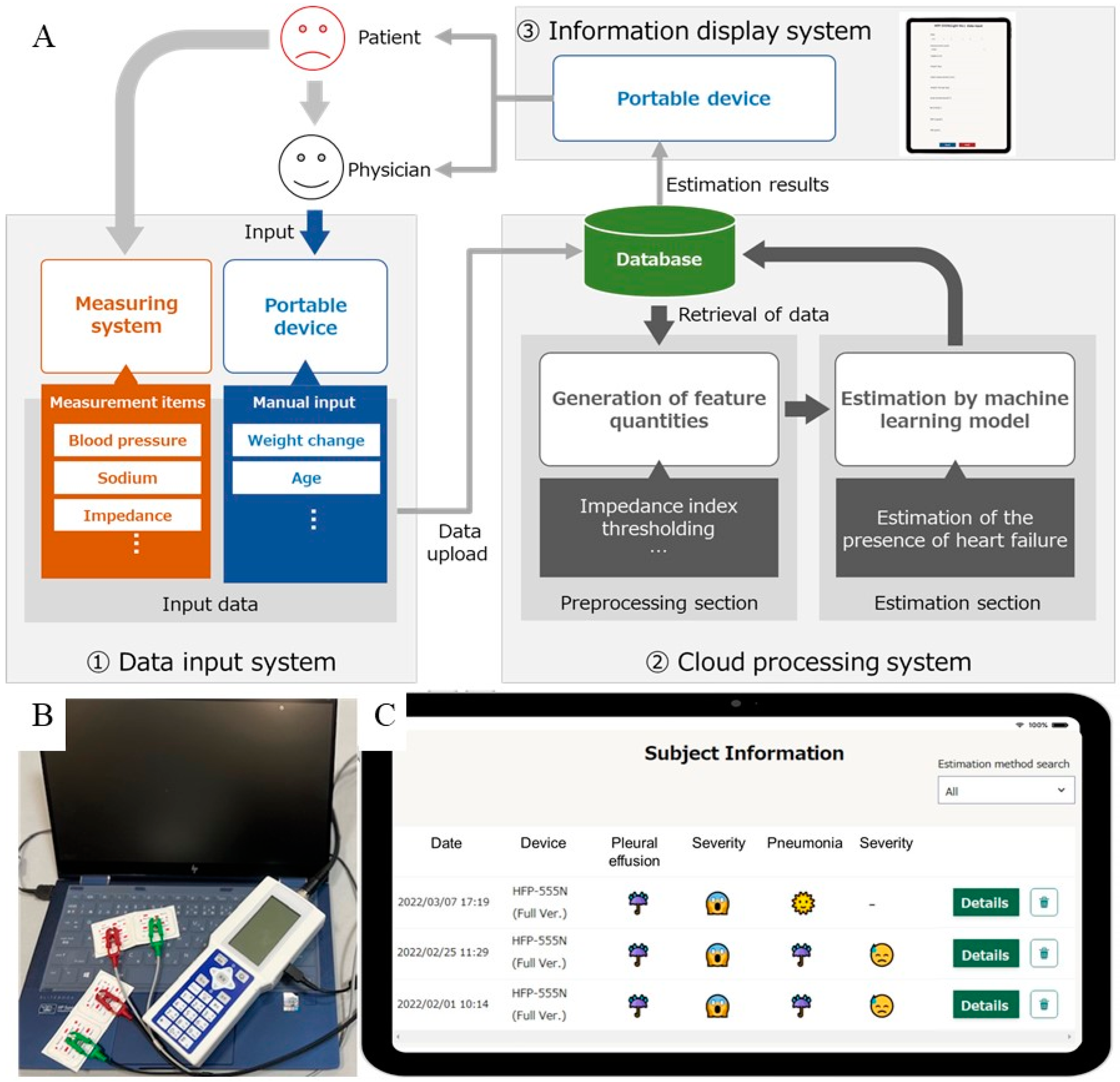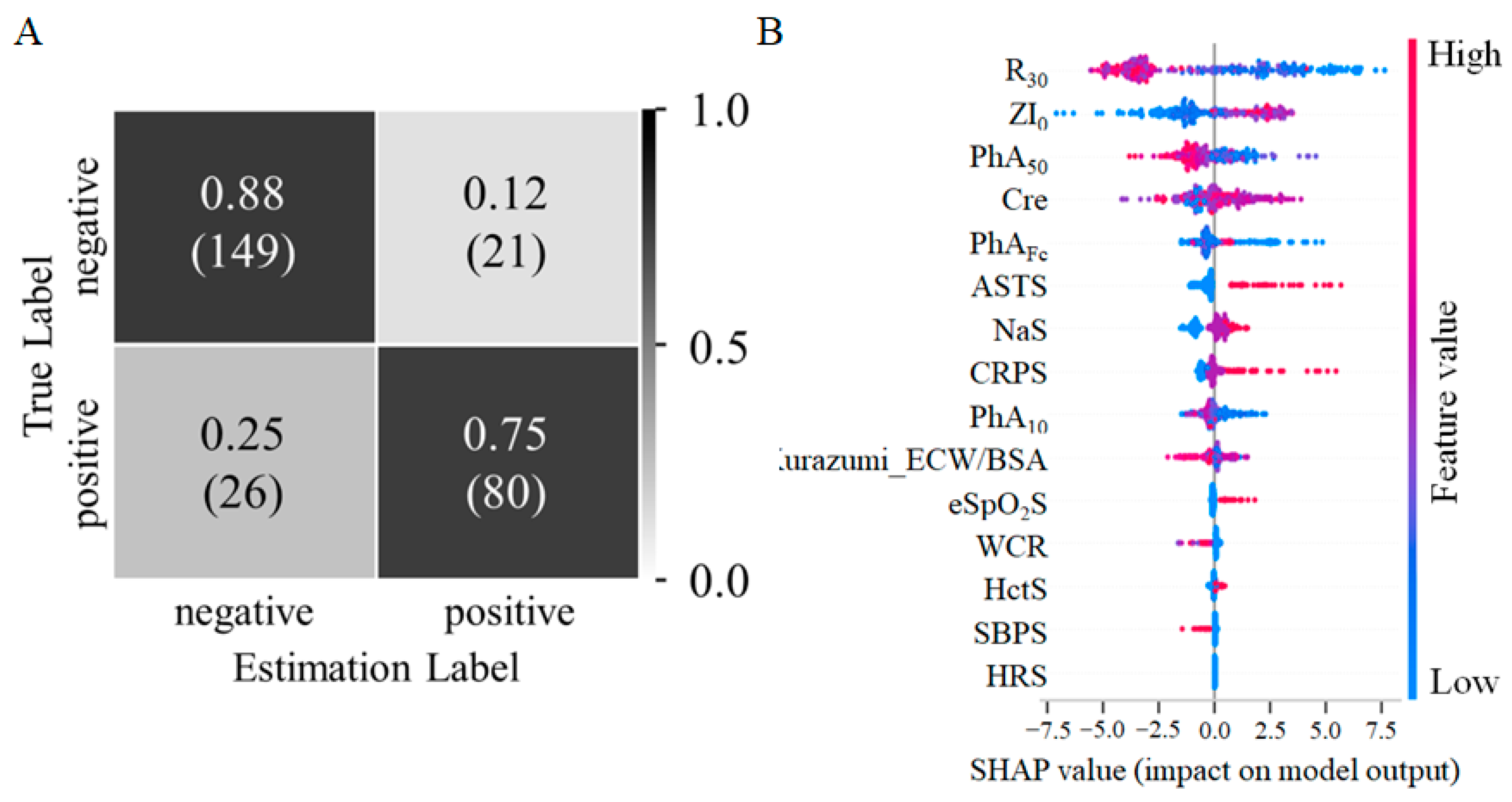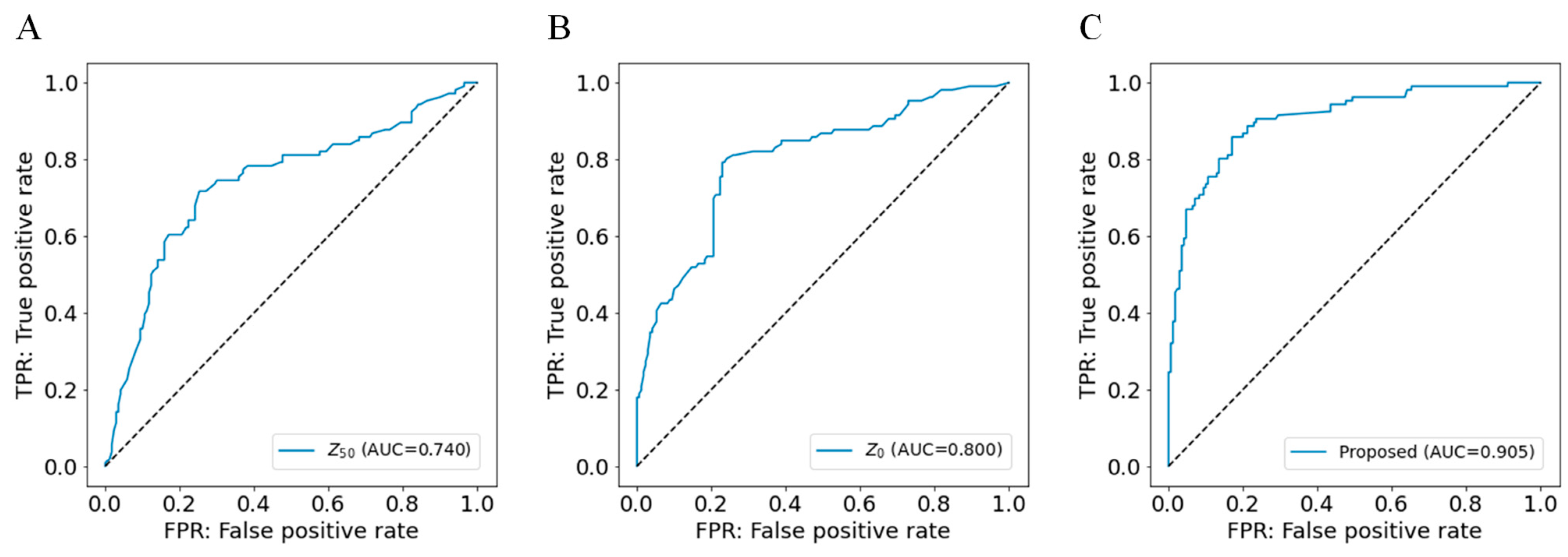Development of Machine Learning-Based Web System for Estimating Pleural Effusion Using Multi-Frequency Bioelectrical Impedance Analyses
Abstract
1. Introduction
2. Materials and Methods
2.1. Study Subjects
2.2. Data Collection
2.3. Machine Learning for Predictive Modeling
2.4. Preprocessing of Data
2.5. Selection of Feature Values
2.6. Development and Evaluation of Machine Learning Models
2.7. Analysis Methods
3. Results
3.1. Overview of the Estimation System
3.2. Model Prediction Performance
3.3. Subject Characteristics
4. Discussion
5. Conclusions
Author Contributions
Funding
Institutional Review Board Statement
Informed Consent Statement
Data Availability Statement
Conflicts of Interest
References
- Savarese, G.; Becher, P.M.; Lund, L.H.; Seferovic, P.; Rosano, G.M.C.; Coats, A. Global burden of heart failure: A comprehensive and updated review of epidemiology. Cardiovasc. Res. 2022, 118, 3272–3287. [Google Scholar] [CrossRef]
- Isobe, M. The Heart Failure “Pandemic” in Japan: Reconstruction of Health Care System in the Highly Aged Society. JMA J. 2019, 2, 103–112. [Google Scholar] [CrossRef] [PubMed]
- Azad, N.; Lemay, G. Management of chronic heart failure in the older population. J. Geriatr. Cardiol. 2014, 11, 329–337. [Google Scholar] [CrossRef]
- Savarese, G.; Lund, L.H. Global Public Health Burden of Heart Failure. Card. Fail. Rev. 2017, 3, 7–11. [Google Scholar] [CrossRef] [PubMed]
- Staub, N.C. Pulmonary edema. Physiol. Rev. 1974, 54, 678–811. [Google Scholar] [CrossRef] [PubMed]
- van Veldhuisen, D.J.; Braunschweig, F.; Conraads, V.; Ford, I.; Cowie, M.R.; Jondeau, G.; Kautzner, J.; Aguilera, R.M.; Lunati, M.; Yu, C.M.; et al. Intrathoracic impedance monitoring, audible patient alerts, and outcome in patients with heart failure. Circulation 2011, 124, 1719–1726. [Google Scholar] [CrossRef]
- Abraham, W.T.; Compton, S.; Haas, G.; Foreman, B.; Canby, R.C.; Fishel, R.; McRae, S.; Toledo, G.B.; Sarkar, S.; Hettrick, D.A. Intrathoracic impedance vs daily weight monitoring for predicting worsening heart failure events: Results of the Fluid Accumulation Status Trial (FAST). Congest. Heart Fail. 2011, 17, 51–55. [Google Scholar] [CrossRef] [PubMed]
- Kyle, U.G.; Bosaeus, I.; De Lorenzo, A.D.; Deurenberg, P.; Elia, M.; Gomez, J.M.; Heitmann, B.L.; Kent-Smith, L.; Melchior, J.C.; Pirlich, M.; et al. Bioelectrical impedance analysis--part I: Review of principles and methods. Clin. Nutr. 2004, 23, 1226–1243. [Google Scholar] [CrossRef] [PubMed]
- Lambert, R.K.; Gremels, H. On the factors concerned in the production of pulmonary oedema. J. Physiol. 1926, 61, 98–112. [Google Scholar] [CrossRef]
- Pomerantz, M.; Baumgartner, R.; Lauridson, J.; Eiseman, B. Transthoracic electrical impedance for the early detection of pulmonary edema. Surgery 1969, 66, 260–268. [Google Scholar]
- Roos, J.C.; Koomans, H.A.; Boer, P.; Dorhout Mees, E.J. Transthoracic electrical impedance as an index of extracellular fluid volume in man. Intensive Care Med. 1985, 11, 39–42. [Google Scholar] [CrossRef]
- Kitsiou, S.; Vatani, H.; Paré, G.; Gerber, B.S.; Buchholz, S.W.; Kansal, M.M.; Leigh, J.; Masterson Creber, R.M. Effectiveness of Mobile Health Technology Interventions for Patients with Heart Failure: Systematic Review and Meta-analysis. Can. J. Cardiol. 2021, 37, 1248–1259. [Google Scholar] [CrossRef] [PubMed]
- Kagiyama, N.; Shrestha, S.; Farjo, P.D.; Sengupta, P.P. Artificial Intelligence: Practical Primer for Clinical Research in Cardiovascular Disease. J. Am. Heart Assoc. 2019, 8, e012788. [Google Scholar] [CrossRef] [PubMed]
- Kerexeta, J.; Larburu, N.; Escolar, V.; Lozano-Bahamonde, A.; Macía, I.; Beristain Iraola, A.; Graña, M. Prediction and Analysis of Heart Failure Decompensation Events Based on Telemonitored Data and Artificial Intelligence Methods. J. Cardiovasc. Dev. Dis. 2023, 10, 48. [Google Scholar] [CrossRef] [PubMed]
- Yashiro, M.; Kotera, H. Association of bioimpedance-derived 50-kHz phase angle as marker of body composition with electrical parameters regarding the Cole-Cole model. Ther. Apher. Dial. 2021, 25, 166–178. [Google Scholar] [CrossRef]
- Ke, G.; Meng, Q.; Finley, T.; Wang, T.; Chen, W.; Ma, W.; Ye, Q.; Liu, T.-Y. LightGBM: A highly efficient gradient boosting decision tree. In Proceedings of the 31st International Conference on Neural Information Processing Systems, Long Beach, CA, USA, 4–9 December 2017; pp. 3149–3157. [Google Scholar]
- Pedregosa, F. Scikit-learn: Machine learning in Python. J. Mach. Learn. Res. 2011, 12, 2825–2830. [Google Scholar]
- Zhang, G.; Shi, Y.; Yin, P.; Liu, F.; Fang, Y.; Li, X.; Zhang, Q.; Zhang, Z. A machine learning model based on ultrasound image features to assess the risk of sentinel lymph node metastasis in breast cancer patients: Applications of scikit-learn and SHAP. Front. Oncol. 2022, 12, 944569. [Google Scholar] [CrossRef]
- Zheng, C.; Tian, J.; Wang, K.; Han, L.; Yang, H.; Ren, J.; Li, C.; Zhang, Q.; Han, Q.; Zhang, Y. Time-to-event prediction analysis of patients with chronic heart failure comorbid with atrial fibrillation: A LightGBM model. BMC Cardiovasc. Disord. 2021, 21, 379. [Google Scholar] [CrossRef]
- MacMahon, S.; Peto, R.; Cutler, J.; Collins, R.; Sorlie, P.; Neaton, J.; Abbott, R.; Godwin, J.; Dyer, A.; Stamler, J. Blood pressure, stroke, and coronary heart disease. Part 1, Prolonged differences in blood pressure: Prospective observational studies corrected for the regression dilution bias. Lancet 1990, 335, 765–774. [Google Scholar] [CrossRef]
- Williams, B.; Mancia, G.; Spiering, W.; Agabiti Rosei, E.; Azizi, M.; Burnier, M.; Clement, D.L.; Coca, A.; de Simone, G.; Dominiczak, A.; et al. 2018 ESC/ESH Guidelines for the management of arterial hypertension. Eur. Heart J. 2018, 39, 3021–3104. [Google Scholar] [CrossRef]
- Page, R.L.; Joglar, J.A.; Caldwell, M.A.; Calkins, H.; Conti, J.B.; Deal, B.J.; Estes, N.A.M., 3rd; Field, M.E.; Goldberger, Z.D.; Hammill, S.C.; et al. 2015 ACC/AHA/HRS Guideline for the Management of Adult Patients with Supraventricular Tachycardia: A Report of the American College of Cardiology/American Heart Association Task Force on Clinical Practice Guidelines and the Heart Rhythm Society. J. Am. Coll. Cardiol. 2016, 67, e27–e115. [Google Scholar] [CrossRef]
- Kusumoto, F.M.; Schoenfeld, M.H.; Barrett, C.; Edgerton, J.R.; Ellenbogen, K.A.; Gold, M.R.; Goldschlager, N.F.; Hamilton, R.M.; Joglar, J.A.; Kim, R.J.; et al. 2018 ACC/AHA/HRS Guideline on the Evaluation and Management of Patients with Bradycardia and Cardiac Conduction Delay: A Report of the American College of Cardiology/American Heart Association Task Force on Clinical Practice Guidelines and the Heart Rhythm Society. Circulation 2019, 140, e382–e482. [Google Scholar] [CrossRef]
- Woodhead, M.; Blasi, F.; Ewig, S.; Garau, J.; Huchon, G.; Ieven, M.; Ortqvist, A.; Schaberg, T.; Torres, A.; van der Heijden, G.; et al. Guidelines for the management of adult lower respiratory tract infections—Full version. Clin. Microbiol. Infect. 2011, 17 (Suppl. 6), E1–E59. [Google Scholar] [CrossRef]
- Sakoi, T.; Mochida, T.; Kurazumi, Y.; Kuwabara, K.; Horiba, Y.; Sawada, S.I. Heat balance model for a human body in the form of wet bulb globe temperature indices. J. Therm. Biol. 2018, 71, 1–9. [Google Scholar] [CrossRef] [PubMed]
- Ma, P.; Liu, R.; Gu, W.; Dai, Q.; Gan, Y.; Cen, J.; Shang, S.; Liu, F.; Chen, Y. Construction and Interpretation of Prediction Model of Teicoplanin Trough Concentration via Machine Learning. Front. Med. 2022, 9, 808969. [Google Scholar] [CrossRef] [PubMed]
- Goodwin, N.L.; Nilsson, S.R.O.; Choong, J.J.; Golden, S.A. Toward the explainability, transparency, and universality of machine learning for behavioral classification in neuroscience. Curr. Opin. Neurobiol. 2022, 73, 102544. [Google Scholar] [CrossRef] [PubMed]
- Kira, S.; Hukushima, Y.; Kitamura, S.; Ito, A. Transthoracic electrical impedance variations associated with respiration. J. Appl. Physiol. 1971, 30, 820–826. [Google Scholar] [CrossRef] [PubMed]
- Goldensohn, E.S.; Zablow, L. An electrical impedance spirometer. J. Appl. Physiol. 1959, 14, 463–464. [Google Scholar] [CrossRef] [PubMed]
- Baker, L.E.; Geddes, L.A.; Hoff, H.E. A comparison of linear and non-linear characterizations of impedance spirometry data. Med. Biol. Eng. 1966, 4, 371–379. [Google Scholar] [CrossRef]
- Zhang, J.; Patterson, R. Non-invasive determination of absolute lung resistivity in adults using electrical impedance tomography. Physiol. Meas. 2010, 31, S45–S56. [Google Scholar] [CrossRef]
- Nebuya, S.; Mills, G.H.; Milnes, P.; Brown, B.H. Indirect measurement of lung density and air volume from electrical impedance tomography (EIT) data. Physiol. Meas. 2011, 32, 1953–1967. [Google Scholar] [CrossRef] [PubMed]
- Spinelli, E.; Mauri, T.; Fogagnolo, A.; Scaramuzzo, G.; Rundo, A.; Grieco, D.L.; Grasselli, G.; Volta, C.A.; Spadaro, S. Electrical impedance tomography in perioperative medicine: Careful respiratory monitoring for tailored interventions. BMC Anesthesiol. 2019, 19, 140. [Google Scholar] [CrossRef] [PubMed]
- Conraads, V.M.; Tavazzi, L.; Santini, M.; Oliva, F.; Gerritse, B.; Yu, C.M.; Cowie, M.R. Sensitivity and positive predictive value of implantable intrathoracic impedance monitoring as a predictor of heart failure hospitalizations: The SENSE-HF trial. Eur. Heart J. 2011, 32, 2266–2273. [Google Scholar] [CrossRef] [PubMed]
- Bhatia, A.; Maddox, T.M. Remote Patient Monitoring in Heart Failure: Factors for Clinical Efficacy. Int. J. Heart Fail. 2021, 3, 31–50. [Google Scholar] [CrossRef]
- Heggermont, W.A.; Van Bockstal, K. Heartlogic(TM): Ready for prime time? Expert. Rev. Med. Devices 2022, 19, 107–111. [Google Scholar] [CrossRef]
- Charach, G.; Karniel, E.; Grosskopf, I.; Charach, L. Monitoring Pleural Effusion in Elderly Patients Using Internal Thoracic Impedance. Isr. Med. Assoc. J. 2020, 22, 94–99. [Google Scholar]
- Charach, G.; Shochat, M.; Rabinovich, A.; Ayzenberg, O.; George, J.; Charach, L.; Rabinovich, P. Preventive treatment of alveolar pulmonary edema of cardiogenic origin. J. Geriatr. Cardiol. 2012, 9, 321–327. [Google Scholar] [CrossRef]
- Van de Water, J.M.; Mount, B.E.; Barela, J.R.; Schuster, R.; Leacock, F.S. Monitoring the chest with impedance. Chest 1973, 64, 597–603. [Google Scholar] [CrossRef]
- Okazaki, N. Clinical significance of the ratio of right and left transthoracic Zo (author’s transl). Jpn. J. Thorac. Dis. 1981, 19, 849–858. [Google Scholar]
- Fein, A.; Grossman, R.F.; Jones, J.G.; Goodman, P.C.; Murray, J.F. Evaluation of transthoracic electrical impedance in the diagnosis of pulmonary edema. Circulation 1979, 60, 1156–1160. [Google Scholar] [CrossRef]
- Kurazumi, Y.; Tsuchikawa, T.; Kakutani, K.; Torii, T.; Matsubara, N.; Horikoshi, T. Evaluation of the conformability of the calculation formula for the body surface area of the human body. Int. J. Biometeorol. 2003, 39, 101–106. [Google Scholar] [CrossRef]
- Olde Rikkert, M.G.; Deurenberg, P.; Jansen, R.W.; van’t Hof, M.A.; Hoefnagels, W.H. Validation of multi-frequency bioelectrical impedance analysis in detecting changes in fluid balance of geriatric patients. J. Am. Geriatr. Soc. 1997, 45, 1345–1351. [Google Scholar] [CrossRef] [PubMed]
- Zhu, F.; Schneditz, D.; Levin, N.W. Sum of segmental bioimpedance analysis during ultrafiltration and hemodialysis reduces sensitivity to changes in body position. Kidney Int. 1999, 56, 692–699. [Google Scholar] [CrossRef] [PubMed]
- Norman, K.; Stobäus, N.; Pirlich, M.; Bosy-Westphal, A. Bioelectrical phase angle and impedance vector analysis--clinical relevance and applicability of impedance parameters. Clin. Nutr. 2012, 31, 854–861. [Google Scholar] [CrossRef] [PubMed]
- Lee, Y.; Kwon, O.; Shin, C.S.; Lee, S.M. Use of bioelectrical impedance analysis for the assessment of nutritional status in critically ill patients. Clin. Nutr. Res. 2015, 4, 32–40. [Google Scholar] [CrossRef]
- Bera, T.K. Bioelectrical Impedance Methods for Noninvasive Health Monitoring: A Review. J. Med. Eng. 2014, 2014, 381251. [Google Scholar] [CrossRef]
- Wang, C.S.; FitzGerald, J.M.; Schulzer, M.; Mak, E.; Ayas, N.T. Does this dyspneic patient in the emergency department have congestive heart failure? JAMA 2005, 294, 1944–1956. [Google Scholar] [CrossRef]
- Diez-Villanueva, P.; Jimenez-Mendez, C.; Alfonso, F. Heart failure in the elderly. J. Geriatr. Cardiol. 2021, 18, 219–232. [Google Scholar] [CrossRef]
- Aiandhealt, H. Subtyping: What It Is and Its Role in Precision Medicine. IEEE Intell. Syst. 2015, 30, 70–75. [Google Scholar]
- Javaid, A.; Zghyer, F.; Kim, C.; Spaulding, E.M.; Isakadze, N.; Ding, J.; Kargillis, D.; Gao, Y.; Rahman, F.; Brown, D.E.; et al. Medicine 2032: The future of cardiovascular disease prevention with machine learning and digital health technology. Am. J. Prev. Cardiol. 2022, 12, 100379. [Google Scholar] [CrossRef]
- Gray, R.; Indraratna, P.; Lovell, N.; Ooi, S.Y. Digital health technology in the prevention of heart failure and coronary artery disease. Cardiovasc. Digit. Health J. 2022, 3, S9–S16. [Google Scholar] [CrossRef] [PubMed]





| Variables | Score | Feature Value |
|---|---|---|
| SBP (mmHg) | 160:1 | SBPS |
| 90–160:0 | ||
| <90:1 | ||
| HR (bpm) | >120:1 | HRS |
| 40–120:0 | ||
| <40:1 | ||
| eSpO2 (%) | ≥90:0 <90:1 | eSpO2S |
| Hct (%) | >50.0:1 | HctS |
| 30.0–50.0:0 | ||
| <30.0:1 | ||
| AST (U/L) | >40:1 | ASTS |
| 10–40:0 | ||
| <10:1 | ||
| Na (mEq/L) | >145:1 | NaS |
| 135–145:0 | ||
| <135:1 | ||
| CRP (mg/dL) | <5.0:0 5.0–10.0:1 ≥10.0:2 | CRPS |
| Weight change percentage from a previous examination (%) | N/A | WCR |
| PhA at 10 kHz (degrees) | N/A | PhA10 |
| PhA at 50 kHz (degrees) | N/A | PhA50 |
| PhA at critical frequency (degrees) | N/A | PhAFc |
| R at 30 kHz (ohm) | N/A | R30 |
| ZI at 0 kHz (cm2/ohm) | N/A | ZI0 |
| ECW normalized via BSA * (kg/m2) | N/A | Kurazumi_ECW/BSA |
| Variable | Healthy Controls (88 Datasets) | Patients at Discharge Without Pleural Effusion (45 Datasets) | p-Value |
|---|---|---|---|
| Gender (Male) (%) | 27.3 | 46.7 | 0.025 |
| Age (years) | 44.8 ± 13.2 | 84.3 ± 11.1 | <0.001 |
| Body weight (kg) | 60.5 ± 13.2 | 45.0 ± 13.8 | <0.001 |
| Height (cm) | 161.1 ± 7.9 | 153.1 ± 10.7 | <0.001 |
| BMI | 23.2 ± 4.0 | 18.9 ± 4.2 | <0.001 |
| Body width (cm) | 32.0 ± 4.0 | 27.7 ± 3.3 | <0.001 |
| Zinf (Ω) | 41.3 ± 16.0 | 31.6 ± 12.0 | <0.001 |
| Z0 (Ω) | 67.2 ± 17.2 | 50.9 ± 20.4 | <0.001 |
| Fc (kHz) | 61.4 ± 23.9 | 59.1 ± 74.2 | 0.132 |
| PhAFc (degrees) | 8.5 ± 2.4 | 11.7 ± 11.9 | 0.127 |
| PhA50 (degrees) | 8.2 ± 2.4 | 5.2 ± 3.1 | <0.001 |
| ZIinf (cm2/ohm) * | 27.3 ± 8.2 | 27.8 ± 12.7 | 0.866 |
| ZI0 (cm2/ohm) * | 15.9 ± 3.7 | 17.1 ± 8.6 | 0.529 |
| Variable | Pleural Effusion + (106 Datasets) | Pleural Effusion − (170 Datasets) | p-Value |
|---|---|---|---|
| Gender (Male) (%) | 49.1 | 34.7 | 0.018 |
| Age (years) | 86.3 ± 9.1 | 63.9 ± 23.0 | <0.001 |
| Body weight (kg) | 47.7 ± 13.7 | 52.6 ± 15.3 | 0.009 |
| Height (cm) | 151.6 ± 10.3 | 157.3 ± 10.1 | <0.001 |
| BMI | 20.7 ± 4.6 | 20.9 ± 4.6 | 0.632 |
| Body width (cm) | 28.2 ± 3.4 | 29.8 ± 4.4 | 0.002 |
| Zinf (Ω) | 22.6 ± 9.7 | 35.6 ± 15.0 | <0.001 |
| Z0 (Ω) | 34.8 ± 34.2 | 56.7 ± 20.9 | <0.001 |
| Fc (kHz) | 67.4 ± 71.2 | 57.1 ± 45.9 | 0.644 |
| PhAFc (degrees) | 8.4 ± 11.5 | 9.5 ± 7.6 | <0.001 |
| PhA50 (degrees) | 3.9 ± 2.1 | 6.8 ± 2.9 | <0.001 |
| ZIinf (cm2/ohm) * | 43.2 ± 28.7 | 28.2 ± 11.0 | <0.001 |
| ZI0 (cm2/ohm) * | 23.3 ± 13.1 | 17.4 ± 7.4 | <0.001 |
Disclaimer/Publisher’s Note: The statements, opinions and data contained in all publications are solely those of the individual author(s) and contributor(s) and not of MDPI and/or the editor(s). MDPI and/or the editor(s) disclaim responsibility for any injury to people or property resulting from any ideas, methods, instructions or products referred to in the content. |
© 2023 by the authors. Licensee MDPI, Basel, Switzerland. This article is an open access article distributed under the terms and conditions of the Creative Commons Attribution (CC BY) license (https://creativecommons.org/licenses/by/4.0/).
Share and Cite
Nose, D.; Matsui, T.; Otsuka, T.; Matsuda, Y.; Arimura, T.; Yasumoto, K.; Sugimoto, M.; Miura, S.-I. Development of Machine Learning-Based Web System for Estimating Pleural Effusion Using Multi-Frequency Bioelectrical Impedance Analyses. J. Cardiovasc. Dev. Dis. 2023, 10, 291. https://doi.org/10.3390/jcdd10070291
Nose D, Matsui T, Otsuka T, Matsuda Y, Arimura T, Yasumoto K, Sugimoto M, Miura S-I. Development of Machine Learning-Based Web System for Estimating Pleural Effusion Using Multi-Frequency Bioelectrical Impedance Analyses. Journal of Cardiovascular Development and Disease. 2023; 10(7):291. https://doi.org/10.3390/jcdd10070291
Chicago/Turabian StyleNose, Daisuke, Tomokazu Matsui, Takuya Otsuka, Yuki Matsuda, Tadaaki Arimura, Keiichi Yasumoto, Masahiro Sugimoto, and Shin-Ichiro Miura. 2023. "Development of Machine Learning-Based Web System for Estimating Pleural Effusion Using Multi-Frequency Bioelectrical Impedance Analyses" Journal of Cardiovascular Development and Disease 10, no. 7: 291. https://doi.org/10.3390/jcdd10070291
APA StyleNose, D., Matsui, T., Otsuka, T., Matsuda, Y., Arimura, T., Yasumoto, K., Sugimoto, M., & Miura, S.-I. (2023). Development of Machine Learning-Based Web System for Estimating Pleural Effusion Using Multi-Frequency Bioelectrical Impedance Analyses. Journal of Cardiovascular Development and Disease, 10(7), 291. https://doi.org/10.3390/jcdd10070291






